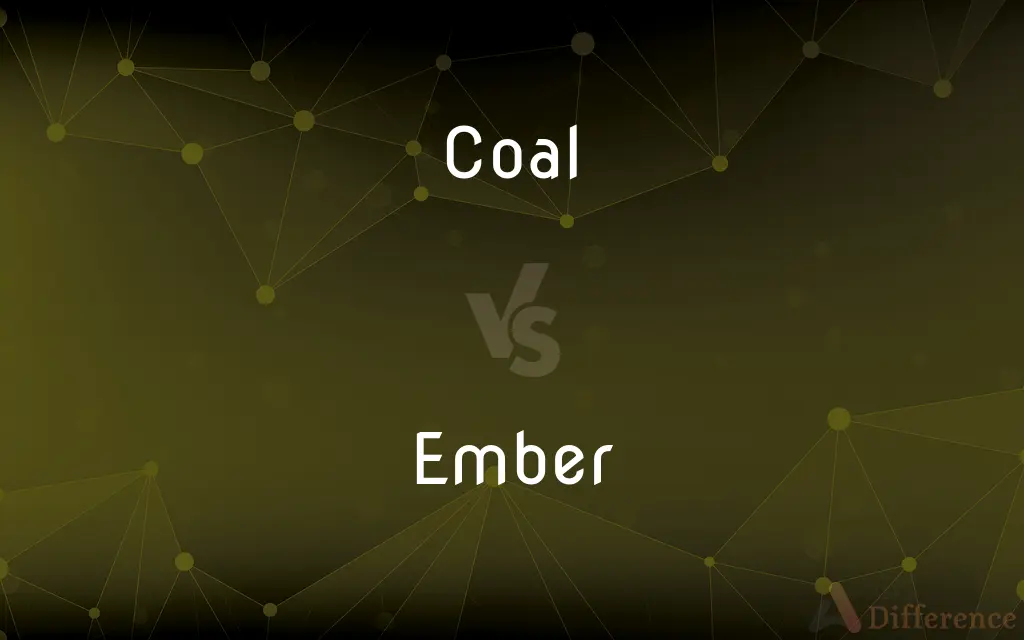Coal vs. Ember — What's the Difference?
By Urooj Arif & Fiza Rafique — Updated on March 28, 2024
Coal is a combustible black or brownish-black sedimentary rock used as fuel, while an ember is a glowing, hot coal or piece of wood from a dying fire.

Difference Between Coal and Ember
Table of Contents
ADVERTISEMENT
Key Differences
Coal is a natural fossil fuel formed from the remains of ancient vegetation under high pressure and temperature over millions of years. It is mined from the earth and used primarily for generating electricity and heating. Coals vary in their properties, such as energy content and carbon percentage, depending on their formation process. On the other hand, embers are the residual hot pieces of coal or wood left in a fire as it burns down. They retain a lot of heat and can glow for hours, capable of igniting a new fire if provided with fuel and oxygen.
While coal is valued for its energy content and is a key commodity in the energy sector, embers are more of a byproduct of combustion, significant in contexts like cooking, heating, or the traditional use of maintaining a fire over long periods. The transformation from coal to ember happens through the process of burning, where coal combusts in the presence of oxygen, releasing heat, and leaving behind embers that continue to radiate heat and glow.
Coal's extraction and use have considerable environmental impacts, including air and water pollution, greenhouse gas emissions, and landscape disruption. Conversely, embers, while not a source of major environmental concern, pose a risk of wildfires if not properly managed in outdoor settings.
In terms of application, coal is a critical resource in industrial processes, power generation, and as a raw material for certain chemical productions. Embers, however, find their use in more controlled environments, such as maintaining warmth in hearths, grilling foods, or in artisanal metalworking, where a consistent heat source is required without the flame.
The handling of coal involves mining, transportation, and storage challenges, given its bulk and dust generation. Handling embers requires caution due to the immediate risk of burns or fire spread, emphasizing the different safety considerations associated with each.
ADVERTISEMENT
Comparison Chart
Nature
Fossil fuel
Byproduct of combustion
Origin
Formed from ancient vegetation
Result of burning coal or wood
Use
Energy generation, heating, industrial processes
Cooking, heating, metalworking
Environmental Impact
Air/water pollution, greenhouse gas emissions
Risk of wildfires if not managed
Handling
Mining, transportation, storage challenges
Caution for burns, fire spread risk
Compare with Definitions
Coal
A combustible black or brownish-black sedimentary rock.
Coal mining is a major industry in some regions.
Ember
A glowing, hot coal or piece of wood in a dying fire.
The embers in the fireplace provided a soft glow.
Coal
Varies in type and energy content.
Anthracite coal is known for its high carbon content and energy efficiency.
Ember
Used in cooking and heating.
Grilling over embers imparts a smoky flavor to food.
Coal
Extracted through mining processes.
Open-pit mining is one method used to extract coal from the earth.
Ember
Retains heat and can ignite a new fire.
Campers used embers to start a fire in the morning.
Coal
Has significant environmental impacts.
Burning coal contributes to air pollution and climate change.
Ember
Byproduct of combustion.
After the bonfire, only a pile of embers remained.
Coal
Used primarily for electricity generation and heating.
The power plant burns coal to produce electricity.
Ember
Requires careful handling to prevent wildfires.
Embers can spark wildfires if not properly extinguished.
Coal
Coal is a combustible black or brownish-black sedimentary rock, formed as rock strata called coal seams. Coal is mostly carbon with variable amounts of other elements, chiefly hydrogen, sulfur, oxygen, and nitrogen.
Ember
An ember is a glowing, hot coal made of greatly heated wood, coal, or other carbon-based material that remain after, or sometimes precede, a fire. Embers can glow very hot, sometimes as hot as the fire which created them.
Coal
A combustible black or dark brown rock consisting chiefly of carbonized plant matter, found mainly in underground seams and used as fuel
A coal fire
Two bags of coal
Ember
A small piece of burning or glowing coal or wood in a dying fire
The dying embers in the grate
The flickering embers of nationalism
Coal
Provide with a supply of coal
Ships had to be coaled and supplied
Ember
A small, glowing piece of coal or wood, as in a dying fire.
Coal
A natural dark brown to black graphitelike material used as a fuel, formed from fossilized plants and consisting of amorphous carbon with various organic and some inorganic compounds.
Ember
Embers The smoldering coal or ash of a dying fire.
Coal
A piece of this substance.
Ember
A glowing piece of coal or wood; a hot coal.
Coal
A glowing or charred piece of solid fuel.
Ember
Smoldering ash.
Coal
Charcoal.
Ember
Making a circuit of the year or the seasons; recurring in each quarter of the year, as certain religious days set apart for fasting and prayer.
Ember fasts
Ember days
Ember weeks
Coal
To burn (a combustible solid) to a charcoal residue.
Ember
A lighted coal, smoldering amid ashes; - used chiefly in the plural, to signify mingled coals and ashes; the smoldering remains of a fire.
He takes a lighted ember out of the covered vessel.
Coal
To provide with coal.
Ember
Making a circuit of the year of the seasons; recurring in each quarter of the year; as, ember fasts.
Coal
To take on coal.
Ember
A hot glowing or smouldering fragment of wood or coal left from a fire
Coal
(uncountable) A black or brownish black rock formed from prehistoric plant remains, composed largely of carbon and burned as a fuel.
The coal in this region was prized by ironmasters in centuries past, who mined it in the spots where the drainage methods of the day permitted.
Coal
(countable) A type of coal, such as bituminous, anthracite, or lignite, and grades and varieties thereof, as a fuel commodity ready to buy and burn.
Put some coal on the fire.
Order some coal from the coalyard.
Coal
(countable) A piece of coal used for burning this use is less common in American English
Put some coals on the fire.
Coal
(countable) A glowing or charred piece of coal, wood, or other solid fuel.
Just as the camp-fire died down to just coals, with no flames to burn the marshmallows, someone dumped a whole load of wood on, so I gave up and went to bed.
Coal
Charcoal.
Coal
(intransitive) To take on a supply of coal (usually of steam ships).
Coal
(transitive) To supply with coal.
To coal a steamer
Coal
(intransitive) To be converted to charcoal.
Coal
(transitive) To burn to charcoal; to char.
Coal
(transitive) To mark or delineate with charcoal.
Coal
A thoroughly charred, and extinguished or still ignited, fragment from wood or other combustible substance; charcoal.
Coal
A black, or brownish black, solid, combustible substance, dug from beds or veins in the earth to be used for fuel, and consisting, like charcoal, mainly of carbon, but more compact, and often affording, when heated, a large amount of volatile matter.
Coal
To burn to charcoal; to char.
Charcoal of roots, coaled into great pieces.
Coal
To mark or delineate with charcoal.
Coal
To supply with coal; as, to coal a steamer.
Coal
To take in coal; as, the steamer coaled at Southampton.
Coal
Fossil fuel consisting of carbonized vegetable matter deposited in the Carboniferous period
Coal
A hot glowing or smouldering fragment of wood or coal left from a fire
Coal
Burn to charcoal;
Without a drenching rain, the forest fire will char everything
Coal
Supply with coal
Coal
Take in coal;
The big ship coaled
Common Curiosities
Why are coal's environmental impacts significant?
Its mining and combustion release pollutants and greenhouse gases, contributing to environmental degradation and climate change.
What exactly is coal?
Coal is a fossil fuel formed from the remains of ancient plants, used primarily for energy and heating.
What are some safe uses of embers?
Embers are used in controlled settings for cooking, heating, or craftwork, ensuring they don't ignite unwanted fires.
How do embers form?
Embers form as coal or wood combusts, leaving behind hot, glowing pieces in the absence of flames.
How has the use of coal changed over time?
While still used for energy, there's a growing shift towards cleaner alternatives due to environmental concerns.
How is coal extracted?
Through surface and underground mining processes, which can significantly alter landscapes and ecosystems.
Can embers be completely extinguished?
Yes, by suffocating them or dousing with water, but care must be taken to ensure they don't reignite.
Can all types of coal produce embers?
Yes, but the quality and duration of the embers can vary based on the coal's properties.
What role do embers play in traditional heating?
They provide a steady source of heat without flames, ideal for maintaining warmth over long periods.
What measures can reduce coal's environmental impact?
Technologies like carbon capture and renewable energy alternatives can mitigate some effects of coal use.
Share Your Discovery

Previous Comparison
Poblano vs. Ancho
Next Comparison
Clay vs. TerracottaAuthor Spotlight
Written by
Urooj ArifUrooj is a skilled content writer at Ask Difference, known for her exceptional ability to simplify complex topics into engaging and informative content. With a passion for research and a flair for clear, concise writing, she consistently delivers articles that resonate with our diverse audience.
Co-written by
Fiza RafiqueFiza Rafique is a skilled content writer at AskDifference.com, where she meticulously refines and enhances written pieces. Drawing from her vast editorial expertise, Fiza ensures clarity, accuracy, and precision in every article. Passionate about language, she continually seeks to elevate the quality of content for readers worldwide.
















































